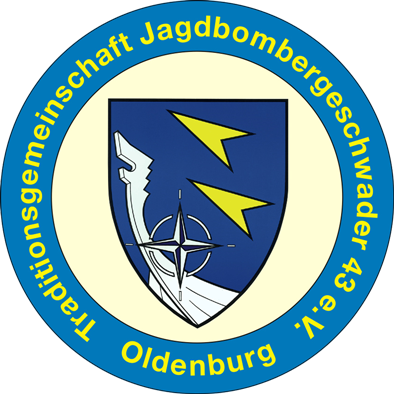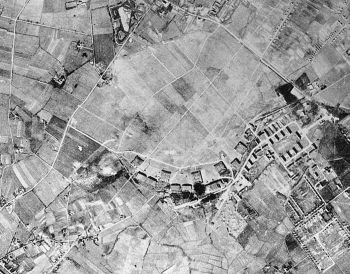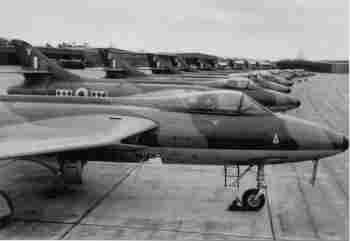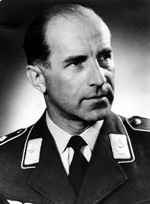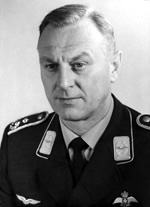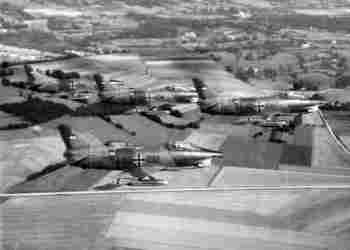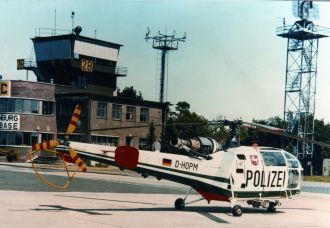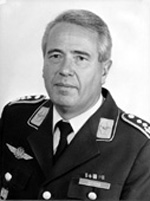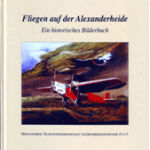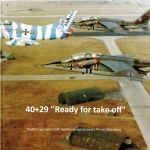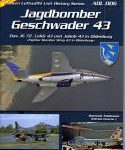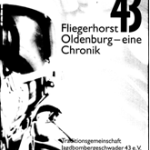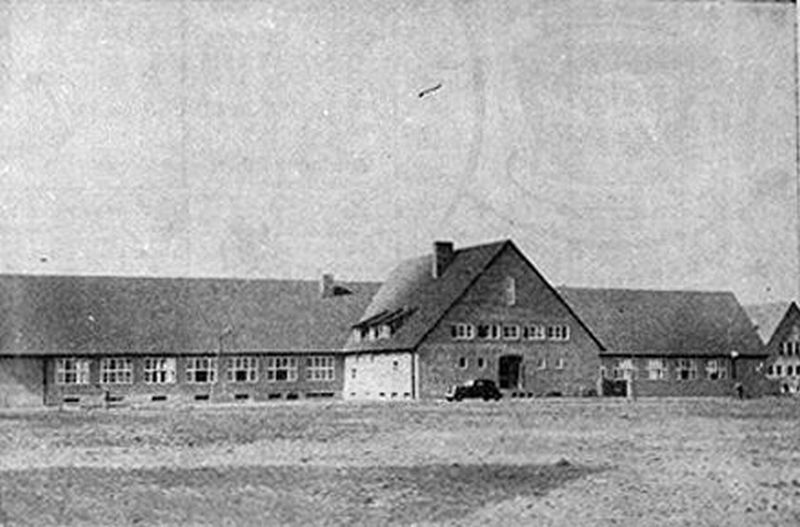
Kitchenbuilding 1936 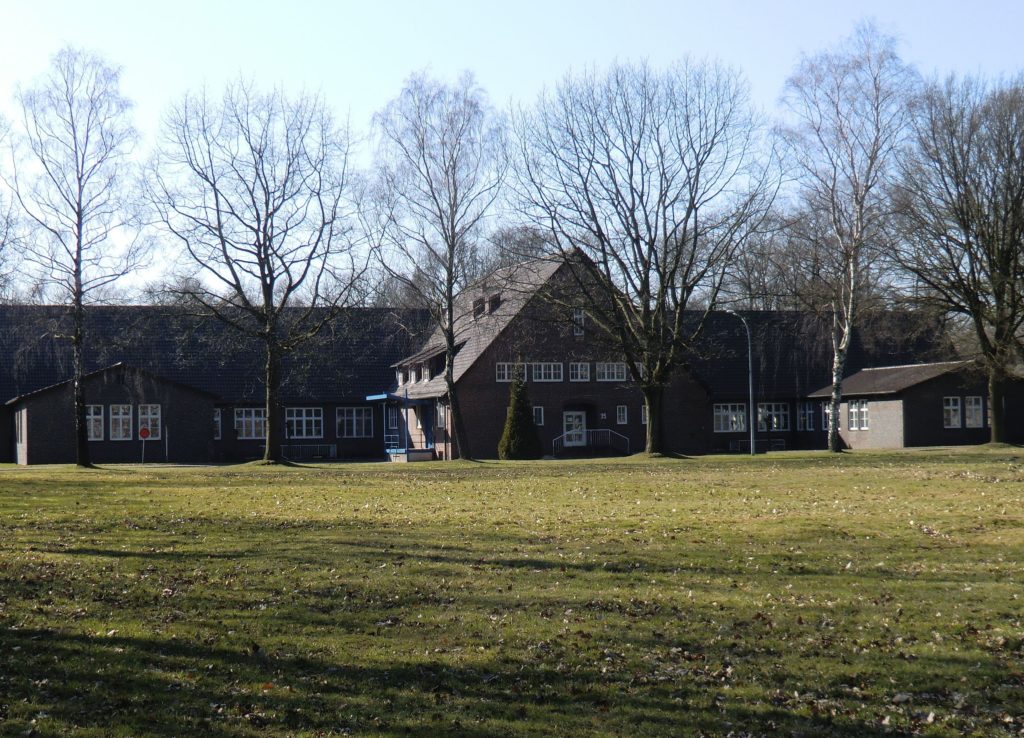
Kitchenbuilding with its present shape
You can also download an 18-page-document about the history of Fliegerhorst Oldenburg (german language):
Please beware of the increased loading times, because of the higher file size.
Below you will find a simplified text version with less images:
Fighter Bomber Wing 43 (Jagdbombergeschwader 43) was decommissioned September 30, 1993, the Oldenburg Air Base operating licence was revoked in 1994 . The loss of the operating license in 1994 marked the end of the aviation history of Oldenburg which had begun as early as 1912.
Flying activities originated at the Rennplatz , then a racetrack, nowadays a housing area. A daring aviator took up his aircraft, called Grade , to 400 metres and managed to land safely, a feat no-one had expected.
Planning for a civil airport in Oldenburg was stopped by World War I, but in the summer of 1924 an air-show at the Rennplatz led to renewed aviation activities in Oldenburg.
The new activities commenced at Alexanderheide in 1925, at first with gliders. Since 1898,Alexanderheide , located far outside the built-up area, had been the training area for troops garrisoned in Oldenburg. A flying association was founded in 1927, and planning began for a civil airport atAlexanderheide . In 1932, the Oldenburg City Council decided to build an airport. Large areas of wood were cleared, and on June 18, 1933 the foundation stone for the first aircraft hangar was layed. Another flying-show celebrated the Opening of Flughafen ( Airport ) Oldenburg/Alexanderheide in August 1933. An immense crowd flooded the new aeronautical facilities. The same year, the new Luftwaffe took over the civil airport, and that was the beginning of intensive infastructural measures. In less than a year and a half, more than 5000 workers built a new military airbase with 13 large A/C hangars and the adjacent barracks , as we know them today. At that time the flying and maneuvreing area ( gras-covered ) was circle of 800 meters in diameter. Precautions went so far as to take down the spire of a near-by church steeple. There was no concrete runway with taxiways yet. They were not constructed until almost 20 years later by the Royal Air Force Germany . In 1934, the new “Flying Training Unit Oldenburg ” (Fliegerübungsstelle Oldenburg) took up its flight activities.
After the existance of a new German Luftwaffe had officially been announced the first soldiers took quarters at the Oldenburg airfield in August 1936.
The first flying unit to start flying activities was “Pilot Training School (B) Oldenburg” (Flugzeugführerschule (B) Oldenburg). They used training gliders Schneider-Grunau SG 38, Arado Ar 66, Ar 88, Bücker Bü 131 und Bü 181, as well as Focke-Wulf Fw 44 and Fw 58, Gotha Go 145, Heinkel He45, Junkers Ju 33 and Klemm Kl 35. At the outbreak of WW II the first combat unit 10th squadron of 3rd group Destroyer Wing 26 “Horst Wessel” ( Zerstörergeschwader 26 “Horst Wessel” ) with their Messerschmitt Me 110 Ds deployed to“Kumpel” ( Buddy) , the code name given to Oldenburg Airbase by the Luftwaffe. From February to May 1940 Weather Exploration Squadron 1 ( Wettererkundungsstaffel 1 ) used the airfield, followed by Bomber Wing 1 “Eagle” ( Kampfgeschwader KG 1 “Adler” ) with Ju 88s. In 1941 Fighter Wing 27 ( Jagdgeschwader JG 27 ) with Me 109 Es , II. Group Bomberwing 3 “Lightning” ( II./KG 3 “Blitz” ) with Dornier Do 17s and Ju 88s was stationed in Oldenburg. For the year 1942 no further information concerning deployment to “Kumpel” is available at present.
3rd Group Fighter Wing 54 “Greenheart” ( III. Gruppe/ JG 54 “Grünherz” ) with its Me 109 G-1/R-2s, -G-4s und -G-6s operated from March to June 1943, followed by several units of “Reich Defence” ( Reichsverteidigung ).
From June 1943 to May 1944 3rd Group of Fighter Wing 11 ( III./JG 11 ) flew against Anglo-American bombers. From July to November 1943 a shortage of aircraft caused the Messerschmitts of III./JG 11 to be used both as day fighters and, at night reassigned to III./JG 300, as night fighters as part of the so-called “Wild Hog” operations ( Wilde Sau ).
After deployement of III./G 300 , III./JG 302 took over and filled their role till end of April 1944. Starting in January 1944, the group coverted to Focke-Wulf Fw 190s in various models: A-5, A-6, A-7 und A-8. Between August and November 1944 JG 54 “Grünherz” with their Fw 190s used “Kumpel2 as its main operation base. Last flying units operating out of Oldenburg March/April 1945 were 7th, 8th and 9th squadrons of III. Group of Night Fighter Wing 11 (Nachtjadggeschwader NJG 11 ) with Me 109 Gs and Fw 190 As
On May 3, 1945, 5 days prior to the end of WW II in europe, Fliegerhorst Oldenburg was taken over by Canadian troops ( 8 Soldiers !! ) after having been abandoned by the Luftwaffe some weeks before. Five days later, it was handed over to the british “Corps of Royal Electrical and Mechanical Engineers” , which turned it into a repairing site for military vehicles, thousands of which passed through the Oldenburg installation for maintainace or repair. Quite often the parts of three damaged vehicles made up a “new” one. The Royal Army left Fliegerhorst Oldenburg in 1949, and the place was left in peace for 2 years. In 1951, Royal Air Force Germany (RAFG) decided to develop Fliegerhorst Oldenburg as the main air base in its area of responsibility. A 7000-foot-long concrete runway with two parallel taxiways and dispersal areas was constructed.
The first British flying unit was No 20 squadron, which remained at “RAF Station Oldenburg” untill the new Luftwaffe assumed command in October 1957. The RAF started flight operations with Vampire Fighter Bombers and changed over to North American “Sabre Mk 6s ” and later Hawker “Hunter F.4s” and “F.5s” in a dayfighter role.
Additional flying units were deployed to Oldenburg: No 234 Sqn and No 26 Sqn, flying Vampires and Sabres in fighterbomber and fighter roles.
In 1954, No 14 squadron with its Hawker Hunters was added until the base was transferred to the Luftwaffe.
The Chronicle of Oldenburg Air Base reports an aircraft crash on July 22, 1955. Upon landing, a Hawker Hunter touched the ground with its wingtip ,turned completely over and collided with two firetrucks and the mobile tower. Several persons were injured and three killed while the pilot survived unharmed. In a military ceremony on October 22, 1957, RAF Station Oldenburg was handed over to Major Meneral Harlinghausen of the new Luftwaffeby British Officers. The Fliegerhorst had become German again.
The first Luftwaffe flying unit was “Waffenschule der Luftwaffe 10 / WaSLw 10” ( Flying Training School 10).
WaSLw 10, under command of Oberstleutnant( LtCol ) Herbert Wehnelt , was to train future German dayfighter pilots with Canadair CL 13B “Sabre Mk 5 ” jetfighters and had gone into service at Nörvenich Air Force Base in the Rhineland.
A short time later, the Luftwaffe decided to transfer WaSLw 10 from Nörvenich to Oldenburg. A total of 75 Sabres Mk 5 arrived in Oldenburg by the end of October 1957.
The Sabres Mk 5 of WaSLw 10 had been modified for the Luftwaffe by Scottish Aviation in Renfrew and made a valuable contribution to the training of the pilots of the future Fighter Wings JG 71 Ahlhorn/Wittmund, JG 72 Leck/Stadum, JG 73 Sobernheim/Pferdsfeld.
These dayfighter units received 225 Canadair Sabre Mk 6 and were commisioned in Oldenburg before being deployed to their newly built home bases.
On November 11, 1959 the new Fighter Wing 72 ( JG 72 ) was commissioned and placed under the command of its first Kommodore ( Commanding Officer ) Major Hohagen, who had been a very succesfull WW II fighter pilot with 55 air victories to his credit and decorated with the Knight’s Cross . The wing then deployed from Oldenburg to Leck, at the very northern German/Danish border.
Two years later the command of the wing changed over from Oberstleutnant ( LtCol ) Hohagen to his deputy, Major Obleser, also a WW II ace who was credited with 127 aerial victories achieved in 500 combat missions. In June 1962, the wing was full assigned to NATO.
When – tongue in cheek – the 2nd Squadron of Fighter Wing 72 (JG 72), the Foxes , was accepted into NATO Tiger Association, newly founded and made up of units with a feline in their shields, the Foxes were first able to participate in a Tiger Meet in the year of the foundation of that group, the premiere meeting held at the American air base of Woodbridge in Great Britain. Precluding possible objections concerning the considerable differences between felines and foxes, the pilot of the participating JB-363 is said to have stated in an authoritative way, “Believe it or not, this IS a tiger!” while pointing at the shield with what was obviously the head of a fox. It seems that nobody chose to challenge that statement, and thus the Foxes were told among the first members of the NATO Tigers.
On July 16, 1959 a third squadron was added to the two existing squadrons of WaSLw 10 at Oldenburg Air Base. It was 3rd/WaSLw 10 that was responsible for training future pilots of the all-weather fighter North American F-86 K, of which a total of 88 had been ordered by the Luftwaffe . The first planes of that type arrived at WaSLw 10 via the depot at Erding on September 10, 1959. They were finally put into service on 1 October 1960 at Leipheim Air Base. The unit was, however, decommissioned a short while after, transferred to Neuburg/Danube Air Base and was renamed Fighter Wing 74 (JG 74). At the beginning of 1960, the first 18 planes of type Sabre VI Mk6 arrived, ordered by the Luftwaffe as a more efficient replacement of the aging Sabre Mk5s.
On April 1, 1962, Reconnaissance Wing 54 (AG 54) was commissioned at Erding Air Base in Bavaria – an event that at the time seemed of little concern to Oldenburg Air Base. The unit was equipped with Fiat G.91/R4s, produced under license by Flugzeugunion Süd (made up of Messerschmidt, Heinkel and Dornier) and to be employed primarily in reconnaissance assignments with the secondary function of close air support.
The commissioning of AG 54 gained relevance, however, for the north German air base of Oldenburg in mid-December 1962 when Reconnaissance Wing 54 commenced its transfer to Oldenburg, completed on 3 April 1963. The three squadrons of WaSLw 10 were transferred from Oldenburg Air Base to Jever Air Base, a transaction completed by 28 February 1963. Oldenburg Air Base was left with Reconnaissance Wing 54 and its Fiat G.91s as its only flying unit. Meanwhile, the command of Fighter Wing 72 at Leck Air Base had been transferred from the 4th Air Defence Division to the 7th Air Force Division. On 19 April 1963, the day when the transfer was made official, Fighter Wing 72 received its official shield out of the hands of Brigadier General Wehnelt. The unit kept it unchanged until the very end despite all changes of assignment and designation over the years. Its three symbols, on a background of air-force blue, were the high-rising bow of a Viking vessel (signifying combat power and the then northernmost position of any Luftwaffe unit), two stylized aircraft (signifying the units aerial assignment) and the NATO rose (signifying the integration into the command structure of the North Atlantic Treaty Organization). On July 15, 1964 the Federal Ministry of Defence issued an order of transfer and renaming of Fighter Wing 72. According to that order, the wing had to relocate from Leck Air Base to Oldenburg Air Base and regroup integrating the personnel of Reconnaissance Wing 54, its dissolution effective 1 October 1964. After the merger the new unit was to carry the name of Fighter Bomber Wing 43 . Since its inception, JG 72 had accumulated more than 53,000 hours in the air. Unlike JG 72 – after its decommissioning and relocation – the shield of the wing remained intact. Even the two squadrons designated “Vikings” and “Foxes” with their Sabre VI aircraft, by now on the way out, were left untouched. Effective on October 1, 1964, Fighter Wing 72 and decommissioned Reconnaissance Wing 54 were officially merged to form Fighter Bomber Wing 43 (JaboG 43) and became part of the 4th Air Force Division; the unit with its new assignment of “fighter bombers” was placed under NATO command. From then on, the aging Sabre VIs were no longer in the role of day fighters but had to yield close air support.
Lieutenant Colonel Schmieder, the last Kommodore of Fighter Wing 72 since December 1963, became the first Kommodore of the new unit.
Colonel Schmieder handed his command on to Colonel Heinz-Günther Kuring on 14 January 1966.
On May 2, 1966, a year and a half after the commissioning of JaboG 43 and after the Sabre VIs had had to change over from the role of fighter airplanes to the role of fighter bombers, the first Fiat G.91/R3 came in from Leipheim Air Base to touch down in Oldenburg. The supply of Fiat G.91/R3s was terminated by the end of 1966.
F-86 Sabre VIs were successively gathered at Oldenburg Air Base and transferred to Iran between 14 March and 3 November 1966. When JaboG 43 had received its complete supply of “Ginas”, the last Sabre VI got its Oldenburg farewell on 20 December 1966. Fighter Bomber Wing 43 was renamed Leichtes Kampfgeschwader 43 (LeKG 43) (Light Weight Attack Wing) on May 1, 1967 and given the assignments of close air support and reconnaissance. Simultaneously, the assignments of the two squadrons were redefined: Former Squadron 1 (the “Vikings”) became Squadron 2, former Squadron 2 (the “Foxes”) was in turn designated as Squadron 1, with reconnaissance its prime assignment while the task of close air support fell to Squadron 2.
After NATO had installed a small multinational rapid response force as early as 1960 that, with little advance warning, could be put into action by Allied Command Europe, the Air Force Command entrusted, among others, the 2nd Squadron of LeKG 43 with securing quick deployment of those “ACE Mobile Forces” (AMF). Inofficially called the “NATO fire brigade”, AMForces were responsible for carrying out assignments quickly at crucial points in a combat zone and at any given time. September 8, 1970 LtCol Bugl took over command from Col Kuring. Construction work on a total of 30 hardened aircraft shelters and other concrete shelters (command post) started in 1971 and was finished in 1973 and repeatedly necessitated the wing to operate from Ahlhorn Air Base.
The next change of command took place when LtCol Laube became Kommodore of the Wing.
April 10, 1975 was listed in the records of the wing as the day when the 100,000th flying hour on Fiat G.91s was credited to LeKG 43.
In 1979 the initial steps were taken for a change of equipment leading to the new weapons system of Alpha Jet, developed by Dassault-Breguet-Dornier.
On September 25, 1986, only five years after the Alpha Jet had been introduced, the unit recorded its 50,000th airborne hour in that aircraft.
At the beginning of 1984, JaboG 43 was the unit to coordinate HIGHWAY 84, a three-week exercise at a newly built section of motorway (Autobahn A 29) serving as an auxiliary air strip (Notlandeplatz NLP). The exercise included aircraft of the U.S. Air Force, the Royal Air Force and of the German, the Dutch and the Norwegian air forces. During an extensive closing demonstration, attended by politicians and by high-ranking officers of the Luftwaffe and of NATO, it was possible to present the NLP concept in a most impressive way. (Cf. the video page)
In November 1987 Captain Thomas Reiter, who subsequently became known as an astronaut, went on record with the 300,000th hour in the air on any aircraft operating under the auspices of the Oldenburg wing. The next change of command took place on September 29, 1988, when Col Merkle took over to LtCol Schad. Among the personnel of Fighter Bomber Wing 43 the most dominant topic of 1989 challenging people’s credulity was certainly that of the potential reunification of Germany and the imminent end of the Cold War. To no one’s surprise, interpersonal German-German relations became much more important than military considerations. That is what five pilots of JaboG 43 must have thought when they left everything to chance and on 11 April 1990 drove their own cars to Laage, the air base of the NVA (National People’s Army) of the German Democratic Republic, situated at almost the same latitude but still very far away. The colleagues-in-air of Fighter Bomber Wing 77 “Gebhard Leberecht von Blücher” (JBG 77) were so delighted by the surprise visit from West Germany that a delegation of the East German unit (including family members) returned the visit on 18 May. The German-German exchange was “officially” initiated when JBG 77 invited JaboG 43 – an invitation that the Oldenburg unit gladly responded to on June 29, 1990. The fact that only a day before a unit of 12 Alpha Jets had left for Goose Bay (Canada) on a three-week training mission seemed negligible in view of the euphoria about a possibly reuniting Germany. Even the invasion of Kuwait by the Iraqi army on 2 August 1960 was simply “registered” by the German public at the time.
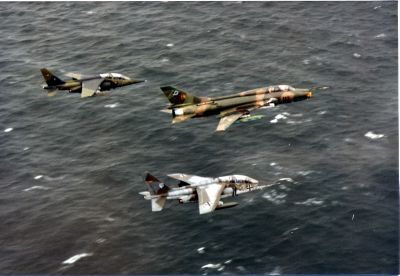
By contrast, an occurrence on the eve of German reunification gained almost world-wide attention: Three Alpha Jets of JaboG 43 flew side-by-side with two Sukhoi Su-22s (“Fitter C”) of JBG 77 of the GDR’s NVA. It is hard to imagine a historically more impressive demonstration of “confraternization in the air”! During the Christmas holidays of 1990, the personnel of the two flying squadrons of JaboG 43 went on full alert for the first time in the history of the unit. On December 17 the imminent transfer of a part of the wing to the border area of Turkey and Iraq was announced.
Right after Christmas a fact-finding team of JaboG 43 travelled from Oldenburg to Turkey for an on-site survey of locations and possibilities. Simultaneously, another team successfully scoured former NVA depots for winter-proof equipment to be used in Turkey; the supplies of the Bundeswehr were considered less than adequate by the soldiers! On January 2, 1991, a possible combat operation of JaboG 43 gained realistic proportions: Due to a decision of the Defence Planning Committee of NATO, No 432Sqd (reenforced by parts of No 431Sqd) had to make all necessary preparations for a transfer to Erhac Air Base in eastern Turkey to safeguard against a possible Iraqi advance in the north. JaboG 43 had become part of NATO operation ACE Guard 91. Between 0240 and 0535 in the morning of January 6, 1991 a total of 18 Alpha Jets of the 2nd squadron of JaboG 43 took off from Oldenburg Air Base for Erhac Air Base in Turkey, home of the F-4Es and RF-4Es of filos (squadrons) 171,172 and 173. The last of JaboG 43’s Alpha Jets touched down in eastern Turkey at 1415 hours.br /> At Erhac Air Base the combat aircraft accomplished combat readiness on January 12, 1991. The next day the Alpha Jets of JaboG 43 took off for their first familarisation flights. On January 16, 1991, a heated debate flared up in the Bundestag (German parliament) over whether the mutual defence cause would be invoked which would have entailed combat action of German aircraft under NATO command. Parliament voted in favor of a continuation of exercises, with JaboG 43 giving close attention. Early in the morning of January 17, 1991, briefly before 0300 local time, air operations of allied forces against the Iraqi aggressor finally took off, an air offensive forming part of the operation that went into the history books by the name of “Operation Desert Storm”. On February 23, 1991 the great allied ground offensive against Iraq was started, which, after devastating allied air strikes, resulted in a ceasefire on February 28, 1991, 0600 local time.
On March 26, 1991, Colonel Volkhard Dessau was installed as the last Kommodore of Fighter Bomber Wing 43.
On September 30, 1993, Fighter Bomber Wing 43 was officially decommissioned. A year later, on 1 November 1994, Oldenburg Air Base was closed as an airfield. The long history of JaboG 43 records more than 400,000 flying hours on all of the aircraft that saw service as wing’s aircraft. Until 2006 when Oldenburg Air Base was permanently reclassified as non-military real estate the grounds were used by Air Missile Defence Group 24 (Flugabwehrraketengruppe 24).
